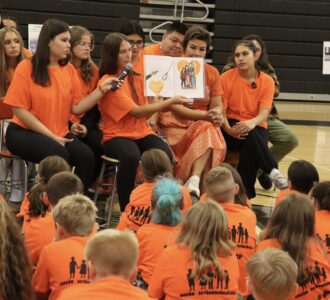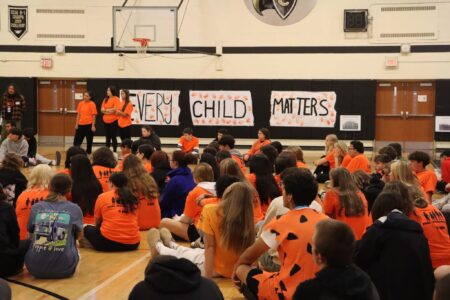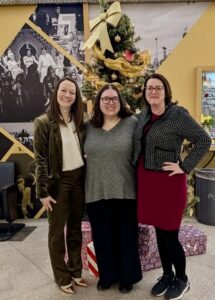Emotional lesson: Students reflect on impact of Remembrance Walk
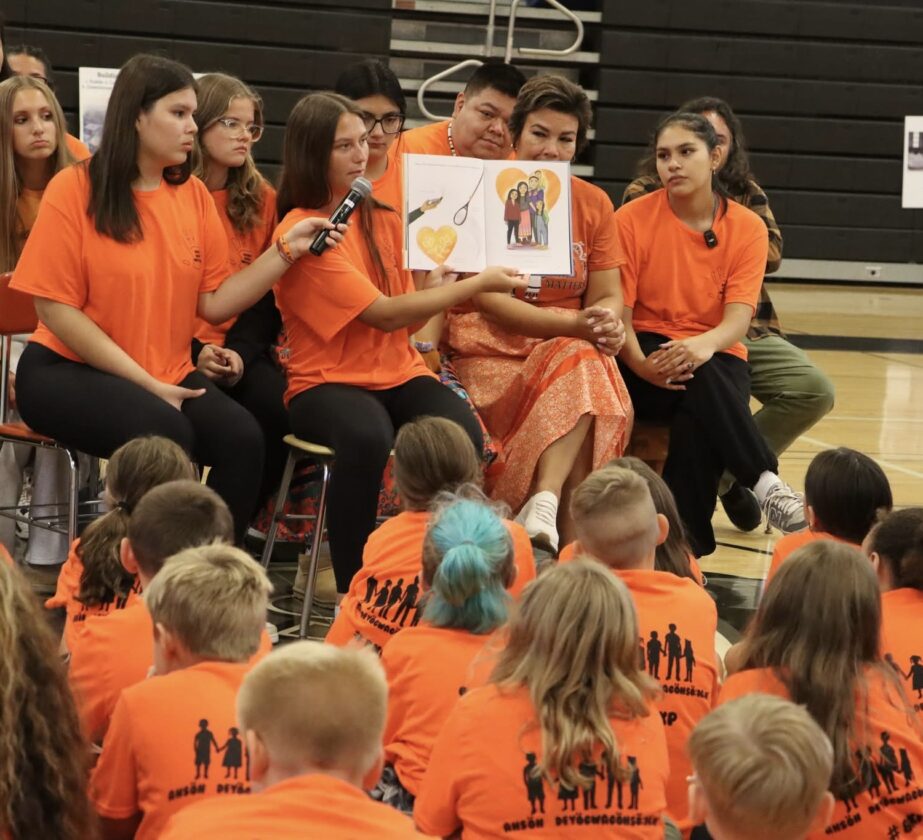
Submitted Photos Skyla Gates holds a microphone as Hailie Rybij reads a book aloud to a gym full of students at a remembrance walk to teach others about indigenous boarding schools
- Submitted Photos Skyla Gates holds a microphone as Hailie Rybij reads a book aloud to a gym full of students at a remembrance walk to teach others about indigenous boarding schools
- the Silver Creek gym was full of students throughout an entire day of presentations of a remembrance walk organized by students Amirya Warrior, Hailie Rybij, and Skyla Gates as part of a Civic Seal initiative.
- Hailie Rybij presents a photo of the infirmary of an indigenous boarding school to two Silver Creek Elementary School students at a remembrance walk hosted last month.
But years later, not many of those little moments that make up each day will leave a lasting impact. Last month, however, three Silver Creek students did something that will be hard to forget.
Amirya Warrior, Hailie Rybij, and Skyla Gates honored their indigenous heritage through a Civic Seal project as they organized a remembrance walk to teach the students of Silver Creek about indigenous boarding schools and the impact they had on their communities. With the support of the Seneca Nation of Indians and guidance from Silver Creek’s Seneca Language and Culture Teacher, Anne Tahamont, the students educated their fellow students about what boarding schools were, the forced assimilation that occurred, and how their lasting effects have impacted multiple generations of indigenous people.
Students of all ages filled the school’s gym, wearing orange shirts designed by Gates and provided by the Seneca Nation as part of the “Every Child Matters” campaign. There were several presentations throughout the day, with each tailored to the age group in the gym at the time.
“I was really proud because they all were able to tailor it for high school, middle school, and two separate groups from the elementary school,” Tahamont said. “They were teachers up there, through and through. They were able to tailor their language, how their mannerisms were, how they got down and sat at eye level with the little kids … they just did it automatically.”
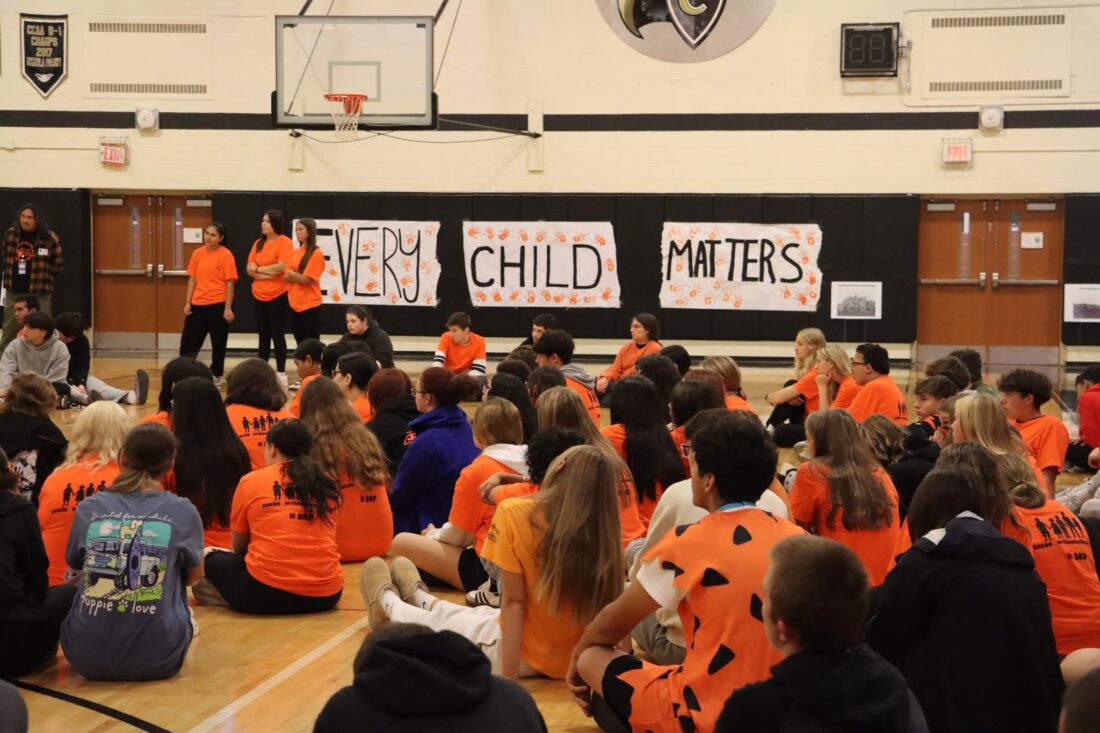
the Silver Creek gym was full of students throughout an entire day of presentations of a remembrance walk organized by students Amirya Warrior, Hailie Rybij, and Skyla Gates as part of a Civic Seal initiative.
Before the event was held, Tahamont brought the students before the Seneca Nation Council to present their proposal. The Council was so impressed that the students were offered support in a variety of ways, including poster boards with photos of indigenous boarding schools to borrow for the event, as well as funding for the custom shirts given to each student. Several members of the Council are Silver Creek graduates.
The walk was initially planned to be held outdoors on the track, but due to rain, it was moved indoors. The last-minute change did not impact the quality of the event. In fact, it might have improved it, as students were confined to a more intimate setting to learn about a part of history that many students are unaware of today.
Elders and officials from the Seneca Nation spoke about their experiences to students of all grades throughout the day, including Gates’ grandmother and uncle. Poster boards were set up throughout the gym to display what a boarding school looked like, from the facilities to the impact on the appearance of students forced to assimilate to Anglo-American culture.
Warrior, Rybij, and Gates are all indigenous students at Silver Creek. Warrior and Rybij are of Seneca descent, while Gates is of the Oneida tribe. Several members of Gates’ family attended indigenous boarding schools, including her grandparents and her uncle. Both her grandmother and uncle attended the remembrance walk to share their experiences.
Tahamont said that when Gates’ grandmother spoke to the middle school group, it was so quiet that “you could hear a pin drop in there.”
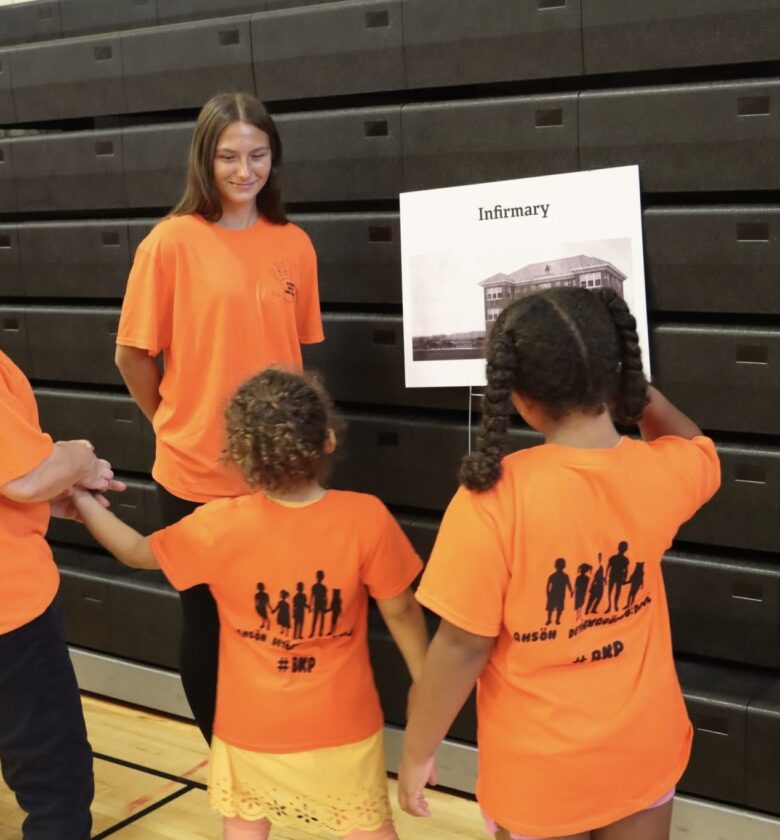
Hailie Rybij presents a photo of the infirmary of an indigenous boarding school to two Silver Creek Elementary School students at a remembrance walk hosted last month.
The students were first inspired to learn more about indigenous boarding schools after hearing differing experiences between when visiting with indigenous elders.
The Thomas Indian School, located on Cattaraugus Territory, was in operation from 1875 until it closed in 1957. This past May, state Gov. Kathy Hochul visited the site to issue a public apology to indigenous families on behalf of the state of New York. Tahamont and her students were in attendance for the monumental event, the first public apology acknowledging wrongdoing at indigenous boarding schools in New York State.
Years after many indigenous boarding schools have been closed, stories of physical, emotional, and sexual abuse throughout the schools became well-known. However, in some cases, students were unaware of the atrocities committed at the schools they attended.
Rybij noted some former students they encountered were not comfortable speaking about their experiences at boarding schools, while others were much more open and even took away positives from their experiences. Perspectives varied between students who were living at the schools and those who were only attending during the day in a schedule resembling a modern schedule.
Many former students of boarding schools were so uncomfortable speaking about their experiences that their only families now did not know they once attended the schools. Tahamont herself only recently learned that her grandmother attended the Thomas Indian School, and once she became aware, it began to make more sense why many members of her family are not outwardly affectionate. Tahamont spoke as a firsthand account of how the trauma inflicted upon members of boarding schools passed on through generations and still impacts indigenous culture through all ages.
However, that was not the case for everyone. Gates’ grandmother had a positive experience attending a boarding school. “She was on good terms with everybody there and she wasn’t treated badly,” Gates said.
While in most cases, indigenous boarding schools are closed, there are still a few schools still in operation across the nation. One former Silver Creek student attended a boarding school out of state, then returned to Silver Creek and shared their experience with Tahamont and several classmates.
“That should be eye opening to anybody, that it is still going on,” Tahamont said.
Tahamont said that in years past, students and staff would share facts pertaining to indigenous boarding schools to educate the rest of the school on the matter, but the impact was minimal. This year, with firsthand accounts from the various speakers at the remembrance walk, along with visuals paired with their accounts, the impact was much clearer.
“They were able to understand more of what happened,” Rybij said. “Instead of just reading facts, reading books or getting information online that isn’t always true, having speakers that were able to talk about their own experience actually brought it to life.”
All three students noticed the impact their presentations had on students of all ages, especially the youngest students. Rybij said the kindergarten through second grade group was the most engaged and curious to learn more. One elementary student raised his hand during the group’s presentation to speak, then proclaimed how what was being done was wrong and unacceptable.
Gates highlighted that students thanked them for their presentations in the Seneca language. “Knowing that our language is still getting out there to all of them that felt really good,” Gates said.
Warrior added, “It’s good that it’s being taught at the younger levels, not just when the kids get to middle school and high school. They are still being introduced to it at a younger age.”
Rybij remembered back to when she first learned about indigenous boarding schools. Now that she is deeply educated on the matter, it was a good feeling to pass on that knowledge to peers and even teachers. “I feel like it made an impact,” she said. “We’ve always talked about doing something, but we never were able to actually plan anything without this project.”
Warrior felt that it was clear to others how much hard work they put into their project. Rybij said teachers they had in elementary school told them how proud they were of how much work they put into their project. The students were invited to read to the elementary students as part of a boarding school unit.
“What is happening here is pretty remarkable,” Tahamont said.
Rybij credited the remembrance walk project and the Civic Seal initiative for helping her become more comfortable communicating with others. While she used to be shy, Rybij said she is now more open about what she thinks and feels.
The Civic Seal initiative is designed to inspire students to make a difference in their community through project based learning. The remembrance walk at Silver Creek not only benefited the students who designed the project, as they gained a deeper understanding of their own culture and what their ancestors faced; it also educated the entire district, across all age groups, about what indigenous boarding schools were and how traumatic the experiences were for many who attended the schools.
The students are not done trying to represent their culture throughout the school district they call home. As part of the next phase of their Civic Seal project, the students plan to hang Seneca Nation and Haudenosaunee flags outside of the school, with a Haudenosaunee flag also to be placed in the gym. The students are hopeful that a ceremony will be scheduled when Silver Creek hosts Gowanda, a division rival with a heavy influence of indigenous culture, during the varsity boys and girls basketball season this winter. More information will be made available at a later date.
“Everyone is always saying we’re doing big things,” Warrior said. “When we are graduated, when we drive by and see the flags up, we’ll know that we did it and we made a change.”

